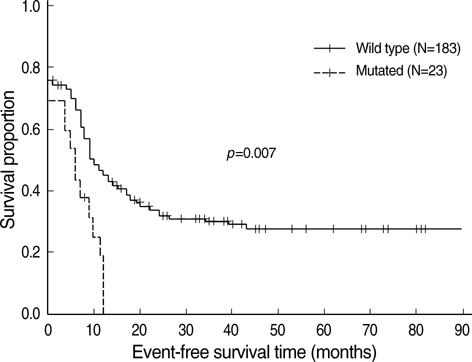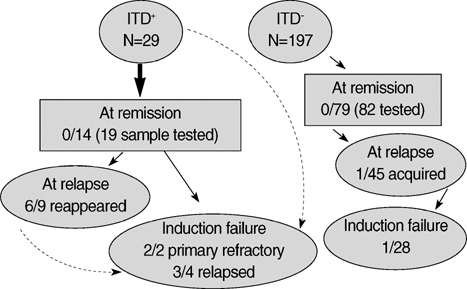J Korean Med Sci.
2008 Oct;23(5):833-837. 10.3346/jkms.2008.23.5.833.
Low Frequency and Variability of FLT3 Mutations in Korean Patients with Acute Myeloid Leukemia
- Affiliations
-
- 1Department of Internal Medicine, Seoul National University Bundang Hospital, Seongnam, Korea.
- 2Department of Laboratory Medicine, Gachon University Gil Hospital, Incheon, Korea.
- 3Department of Internal Medicine, Gachon University Gil Hospital, Incheon, Korea. jhlee@gilhospital.com
- 4Department of Pediatrics, Gachon University Gil Hospital, Incheon, Korea.
- 5Department of Laboratory Medicine, Inje University Sanggye Paik Hospital, Seoul, Korea.
- 6Department of Hematology-Oncology. Chonnam National University Medical School, Gwangju, Korea.
- 7Genome Research Center for Hematopoietic Diseases, Chonnam National University Hwasun Hospital, Hwasun, Korea.
- 8Department of Pediatrics, Seoul National University College of Medicine, Seoul, Korea.
- KMID: 1783069
- DOI: http://doi.org/10.3346/jkms.2008.23.5.833
Abstract
- FLT3 mutations are common genetic changes, and are reported to have prognostic significance in acute myeloid leukemia (AML). The FLT3 internal tandem duplication (ITD) and the D835 activating mutation in the tyrosine kinase domain (TKD) were analyzed by polymerase chain reaction (PCR) in the genomic DNA of Korean patients with AML at diagnosis and during follow-up. There were 226 patients with AML enrolled between March 1996 and August 2005. The incidence of ITD and TKD at diagnosis was 13% (29/226) and 3% (6/226). When compared to Western and other Asian patients with AML, Korean patients had a lower frequency by about two-thirds of ITD and TKD. Among the non-M3 cases (N=203), the patients with an ITD had a significantly shorter event-free survival when compared with those without an ITD (p=0.0079). Among 54 relapsed patients, 9 patients had the FLT3 ITD at diagnosis. Six patients demonstrated a reappearance of the ITD and 3 patients remained negative at relapse. One patient, among 45 patients who relapsed, had a negative baseline ITD but acquired a de novo ITD at relapse. There were 101 samples from 93 patients in remission; they were all negative for an ITD. Among 34 patients who failed to achieve a remission, five patients had a persistent ITD and one patient had a de novo ITD. These results support the concept of resistance of FLT3 ITD leukemic clones to chemotherapy. Therefore, effective therapy with FLT3 targeting agents may improve the prognosis of non-M3 AML patients with the FLT3 mutation.
Keyword
MeSH Terms
Figure
Reference
-
1. Nakao M, Yokota S, Iwai T, Kaneko H, Horiike S, Kashima K, Sonoda Y, Fujimoto T, Misawa S. Internal tandem duplication of the flt3 gene found in acute myeloid leukemia. Leukemia. 1996. 10:1911–1918.2. Yokota S, Kiyoi H, Nakao M, Iwai T, Misawa S, Okuda T, Sonoda Y, Abe T, Kahsima K, Matsuo Y, Naoe T. Internal tandem duplication of the FLT3 gene is preferentially seen in acute myeloid leukemia and myelodyplastic syndrome among various hematological malignancies. A study on a large series of patients and cell lines. Leukemia. 1997. 11:1605–1609.3. Kiyoi H, Naoe T. FLT3 in human hematologic malignancies. Leuk Lymphoma. 2002. 43:1541–1547.
Article4. Yamamoto Y, Kiyoi H, Nakano Y, Suzuki R, Kodera Y, Miyawaki S, Asou N, Kuriyama K, Yagasaki F, Shimazaki C, Akiyama H, Saito K, Nishimura M, Motoji T, Shinagawa K, Takeshita A, Saito H, Ueda R, Ohno R, Naoe T. Activating mutation of D835 within the activation loop of FLT3 in human hematologic malignancies. Blood. 2001. 97:2434–2439.
Article5. Abu-Duhier FM, Goodeve AC, Wilson GA, Care RS, Peake IR, Reilly JT. Identification of novel FLT-3 Asp835 mutations in adult acute myeloid leukaemia. Br J Haematol. 2001. 113:983–988.
Article6. Spiekermann K, Bagrintseva K, Schoch C, Haferlach T, Hiddemann W, Schnittger S. A new recurrent activating length mutation in exon 20 of the FLT3 gene in acute myeloid leukemia. Blood. 2002. 100:3423–3425.7. Stirewalt DL, Radich JP. The role of FLT3 in haematopoietic malignancies. Nat Rev Cancer. 2003. 3:650–665.
Article8. Thiede C, Steudel C, Mohr B, Schaich M, Schakel U, Platzbecker U, Wermke M, Bornhauser M, Ritter M, Neubauer A, Ehninger G, Illmer T. Analysis of FLT3-activating mutations in 979 patients with acute myelogenous leukemia: association with FAB subtypes and identification of subgroups with poor prognosis. Blood. 2002. 99:4326–4335.
Article9. Kiyoi H, Naoe T, Nakano Y, Yokota S, Minami S, Miyawaki S, Asou N, Kuriyama K, Jinnai I, Shimazaki C, Akiyama H, Saito K, Oh H, Motoji T, Omoto E, Saito H, Ohno R, Ueda R. Prognostic implication of FLT3 and N-RAS gene mutations in acute myeloid leukemia. Blood. 1999. 93:3074–3080.10. Boissel N, Cayuela JM, Preudhomme C, Thomas X, Grardel N, Fund X, Tigaud I, Raffoux E, Rousselot P, Sigaux F, Degos L, Castaigne S, Fenaux P, Dombret H. Prognostic significance of FLT3 internal tandem repeat in patients with de novo acute myeloid leukemia treated with reinforced courses of chemotherapy. Leukemia. 2002. 16:1699–1704.
Article11. Kottaridis PD, Gale RE, Frew ME, Harrison G, Langabeer SE, Belton AA, Walker H, Wheatley K, Bowen DT, Burnett AK, Goldstone AH, Linch DC. The presence of a FLT3 internal tandem duplication in patients with acute myeloid leukemia (AML) adds important prognostic information to cytogenetic risk group and response to the first cycle of chemotherapy: analysis of 854 patients from the United Kingdom Medical Research Council AML 10 and 12 trials. Blood. 2001. 98:1752–1759.
Article12. Kainz B, Heintel D, Marculescu R, Schwarzinger I, Sperr W, Le T, Weltermann A, Fonatsch C, Haas OA, Mannhalter C, Lechner K, Jaeger U. Variable prognostic value of FLT3 internal tandem duplications in patients with de novo AML and a normal karyotype, t(15;17), t(8;21) or inv(16). Hematol J. 2002. 3:283–289.
Article13. Schnittger S, Schoch C, Dugas M, Kern W, Staib P, Wuchter C, Loffler H, Sauerland CM, Serve H, Buchner T, Haferlach T, Hiddemann W. Analysis of FLT3 length mutations in 1003 patients with acute myeloid leukemia: correlation to cytogenetics, FAB subtype, and prognosis in the AMLCG study and usefulness as a marker for the detection of minimal residual disease. Blood. 2002. 100:59–66.
Article14. Kim YK, Lee JJ, Lee YR, Lee IK, Lee HN, Kim NY, Park KS, Yang DH, Park MR, Kim HJ. The presence of FLT3/ITD mutations is an independent prognostic factor in acute myeloid leukemia patients with normal karyotype. Blood. 2004. 104:3008a.
Article15. Moreno I, Martin G, Bolufer P, Barragan E, Rueda E, Roman J, Fernandez P, Leon P, Mena A, Cervera J, Torres A, Sanz MA. Incidence and prognostic value of FLT3 internal tandem duplication and D835 mutations in acute myeloid leukemia. Haematologica. 2003. 88:19–24.16. Kang HJ, Hong SH, Kim IH, Park BK, Han KS, Cho HI, Shin HY, Ahn HS. Prognostic significance of FLT3 mutations in pediatric non-promyelocytic acute myeloid leukemia. Leuk Res. 2005. 29:617–623.
Article17. Nakano Y, Kiyoi H, Miyawaki S, Asou N, Ohno R, Saito H, Naoe T. Molecular evolution of acute myeloid leukaemia in relapse: unstable N-ras and FLT3 genes compared with p53 gene. Br J Haematol. 1999. 104:659–664.
Article18. Mead A, Linch D, Hills R, Wheatley K, Burnett A, Gale R. Favourable prognosis associated with FLT3 tyrosine kinase domain mutations in AML in contrast to the adverse outcome associated with internal tandem duplications. Blood. 2005. 106:334a.
Article19. Shih LY, Huang CF, Wu JH, Lin TL, Dunn P, Wang PN, Kuo MC, Lai CL, Hsu HC. Internal tandem duplication of FLT3 in relapsed acute myeloid leukemia: a comparative analysis of bone marrow samples from 108 adult patients at diagnosis and relapse. Blood. 2002. 100:2387–2392.
Article20. Hovland R, Gjertsen BT, Bruserud O. Acute myelogenous leukemia with internal tandem duplication of the Flt3 gene appearing or altering at the time of relapse: a report of two cases. Leuk Lymphoma. 2002. 43:2027–2029.
Article21. Tiesmeier J, Muller-Tidow C, Westermann A, Czwalinna A, Hoffmann M, Krauter J, Heil G, Ganser A, Serve H, Verbeek W. Evolution of FLT3-ITD and D835 activating point mutations in relapsing acute myeloid leukemia and response to salvage therapy. Leuk Res. 2004. 28:1069–1074.
Article22. Cloos J, Zwaan CM, Corthals SL, Goemans BF, Waisfisz Q, Creutzig U, Reinhardt D, Hahlen K, Kaspers GJL. FLT3/internal tandem duplication in paired presentation and relapse pediatric AML. Blood. 2004. 102:334a.23. Grimwade D, Walker H, Oliver F, Wheatley K, Harrison C, Harrison G, Rees J, Hann I, Stevens R, Burnett A, Goldstone A. The importance of diagnostic cytogenetics on outcome in AML: analysis of 1,612 patients entered into the MRC AML 10 trial. The medical research council adult and children's leukaemia working parties. Blood. 1998. 92:2322–2333.24. Wang L, Lin D, Zhang X, Chen S, Wang M, Wang J. Analysis of FLT3 internal tandem duplication and D835 mutations in Chinese acute leukemia patients. Leuk Res. 2005. 29:1393–1398.
Article25. Yoo SJ, Park CJ, Jang S, Seo EJ, Lee KH, Chi HS. Inferior prognostic outcome in acute promyelocytic leukemia with alteration of FLT3 gene. Leuk Lymphoma. 2006. 47:1788–1793.26. Kong SY, Ki CS, Lee SG, Hong SA, Kim JW, Kim SH. Analysis of FLT3-activiating mutations in 77 patients with acute myelogenous leukemia; association with WHO classification. Korean J Hematol. 2003. 38:44a.27. Zwaan CM, Meshinchi S, Radich JP, Veerman AJ, Huismans DR, Munske L, Podleschny M, Hahlen K, Pieters R, Zimmermann M, Reinhardt D, Harbott J, Creutzig U, Kaspers GJ, Griesinger F. FLT3 internal tandem duplication in 234 children with acute myeloid leukemia: prognostic significance and relation to cellular drug resistance. Blood. 2003. 102:2387–2394.
Article28. Lacayo NJ, Meshinchi S, Raimondi SC, Kuo DJ, Yu R, Chang MN, Willman CL, Tibshirani R, Ravindranath Y, Sikic BI, Weinstein , Dahl GV. FLT3 mutations determine the clinical outcome in children with de novo acute myelogenous leukemia (AML) and normal karyotype: Pediatric Oncology Group (POG) Study # 9421. Blood. 2004. 104:570a.
Article29. Slovak ML, Kopecky KJ, Cassileth PA, Harrington DH, Theil KS, Mohamed A, Paietta E, Willman CL, Head DR, Rowe JM, Forman SJ, Appelbaum FR. Karyotypic analysis predicts outcome of preremission and postremission therapy in adult acute myeloid leukemia: a Southwest Oncology Group/Eastern Cooperative Oncology Group Study. Blood. 2000. 96:4075–4083.
Article30. Gale RE, Hills R, Pizzey AR, Kottaridis PD, Swirsky D, Gilkes AF, Nugent E, Mills KI, Wheatley K, Solomon E, Burnett AK, Linch DC, Grimwade D. NCRI Adult Leukaemia Working Party. Relationship between FLT3 mutation status, biologic characteristics, and response to targeted therapy in acute promyelocytic leukemia. Blood. 2005. 106:3768–3776.31. Sternberg DW, Licht JD. Therapeutic intervention in leukemias that express the activated fms-like tyrosine kinase 3 (FLT3): opportunities and challenges. Curr Opin Hematol. 2005. 12:7–13.
Article32. Kuchenbauer F, Schoch C, Kern W, Hiddemann W, Haferlach T, Schnittger S. Impact of FLT3 mutations and promyelocytic leukaemiabreakpoint on clinical characteristics and prognosis in acute promyelocytic leukaemia. Br J Haematol. 2005. 130:196–202.
Article
- Full Text Links
- Actions
-
Cited
- CITED
-
- Close
- Share
- Similar articles
-
- FLT3 mutations in acute myeloid leukemia: a review focusing on clinically applicable drugs
- Gilteritinib Reduces FLT3 Expression in Acute Myeloid Leukemia Cells
- Molecular Risk Stratification using Next-generation Sequencing in Acute Myeloid Leukemia
- FLT3 Gene Mutations as a Prognostic Factor for Acute Myeloid Leukemia
- High Transcript Level of FLT3 Associated with High Risk of Relapse in Pediatric Acute Myeloid Leukemia



